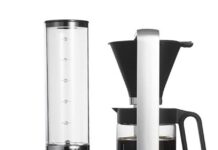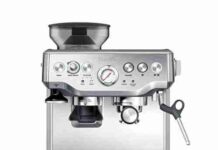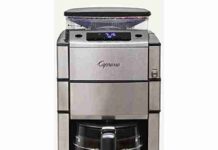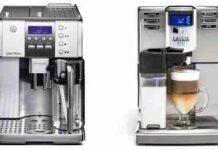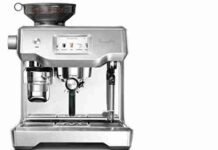Ever wondered why your morning cup of joe tastes a little off when brewed by a coffee machine? The answer lies in the delicate balance between heat and extraction. In this article, we will uncover the mysterious phenomenon behind the occasional burnt taste that can spoil even the finest beans and reveal tips on how to prevent it from happening. So grab a fresh brew and join us on this exploration of the science behind your morning pick-me-up.
Roasting Process
Temperature during roasting
In the roasting process, temperature plays a crucial role in determining the flavor profile of the coffee beans. Roasting is done at various temperatures, ranging from light to dark roasts. When coffee beans are subjected to higher temperatures, they undergo a chemical reaction called the Maillard reaction. This reaction leads to the formation of aromatic compounds and gives the coffee its distinctive flavor. However, if the temperature during roasting is too high, it can result in a burnt taste in the final brew.
Duration of roasting
The duration of roasting also impacts the flavor of the coffee. Depending on the desired roast level, coffee beans are roasted for different lengths of time. Longer roasting times result in darker roasts, which tend to have a stronger and more bitter taste. On the other hand, shorter roasting times result in lighter roasts, which often have a brighter and more acidic flavor. It is essential for coffee roasters to strike the right balance between temperature and duration to achieve the desired flavor profile without the taste becoming overwhelmingly burnt.
Dark roast vs light roast
The choice between dark and light roasts is a matter of personal preference. Dark roasts are typically characterized by their oily surface and a bold, smoky flavor. They are roasted for a longer duration at higher temperatures, resulting in a more robust and full-bodied taste. Light roasts, on the other hand, have a lighter color and retain more of their original flavors. They are roasted for a shorter duration at lower temperatures, preserving the delicate nuances and acidity of the coffee beans. Ultimately, it is up to the consumer to decide which roast profile they prefer.
Coffee Machine Temperature
Significance of temperature in brewing
The temperature of the water during brewing plays a vital role in extracting the flavors and aromas from the coffee grounds. Ideally, the water temperature should be between 195 to 205 degrees Fahrenheit (90 to 96 degrees Celsius) for optimal flavor extraction. If the water temperature is too low, it may result in under-extraction, leading to a weak and bland cup of coffee. Conversely, if the water temperature is too high, it can lead to over-extraction, resulting in a burnt and bitter taste.
Overheating of coffee machine
One common reason why coffee sometimes tastes burnt from a coffee machine is the overheating of the machine itself. If the coffee machine is not properly calibrated or if the heating element is faulty, it can cause the water temperature to exceed the desired range. This can lead to over-extraction of the coffee grounds and result in a burnt taste in the brewed coffee. It is important to regularly check and maintain the temperature control mechanisms of the coffee machine to ensure a consistent brewing temperature.
Burnt taste due to high brewing temperature
Another factor that can contribute to a burnt taste in coffee is brewing with water that is too hot. If the water temperature exceeds the recommended range, it can over-extract the coffee grounds and release bitter compounds. This can result in a harsh and unpleasant burnt flavor in the brewed coffee. It is essential to pay attention to the water temperature used in the brewing process to achieve a balanced and well-extracted cup of coffee.
Stale Coffee Beans
Effects of stale beans on taste
The freshness of coffee beans greatly influences the flavor of the brewed coffee. When coffee beans go stale, they lose their natural sweetness and develop a stale, flat taste. Stale beans can also result in a muted aroma, making the coffee less enjoyable to drink. The longer coffee beans are stored, the more likely they are to become stale, so it is crucial to use fresh beans for the best flavor.
Chemical changes in coffee beans over time
Over time, coffee beans undergo chemical changes that affect their flavor. The exposure to air and moisture causes the coffee beans to oxidize and degrade. This oxidation process leads to the breakdown of complex compounds, resulting in a loss of flavor and aroma. Additionally, the oils within the beans can become rancid, further contributing to the stale taste. To preserve the freshness of coffee beans, it is best to store them in airtight containers away from light, heat, and moisture.
Impact of storage conditions on freshness
The way coffee beans are stored can have a significant impact on their freshness and flavor. Ideally, coffee beans should be stored in a cool, dark, and dry place to maintain their quality. Exposure to air, heat, and light can speed up the oxidation process and lead to the beans becoming stale more quickly. It is also advisable to store coffee beans in whole bean form and grind them just before brewing to preserve their freshness. By paying attention to how coffee beans are stored, we can ensure a more flavorful and less burnt-tasting cup of coffee.
Improper Grinding
Importance of grinding size
Grinding the coffee beans to the appropriate size is crucial for achieving the desired flavor in the brewed coffee. Different brewing methods require different grind sizes to optimize the extraction process. For example, a coarser grind is typically used for French press, while a finer grind is required for espresso. The grind size affects the surface area of the coffee particles exposed to the water, influencing the rate and efficiency of extraction. Using an improper grind size can result in under-extraction or over-extraction, leading to a burnt taste.
Effect of improper grinding on taste
When coffee beans are ground too finely, it can lead to over-extraction during brewing. The water may struggle to flow through the compacted coffee grounds, resulting in a longer brewing time and a burnt taste in the final cup. Conversely, if the coffee beans are ground too coarsely, the water can pass through too quickly, resulting in under-extraction and a weak, sour taste. Achieving the right grind size is essential to ensure balanced flavor extraction and to prevent the coffee from tasting burnt.
Burnt taste due to inconsistent grind size
Inconsistent grind size can also contribute to a burnt taste in coffee. If some particles are much finer or coarser than the rest, they will extract at different rates, resulting in an uneven brew. The finer particles can become over-extracted and contribute to the burnt taste, while the coarser particles may remain under-extracted and result in a weak flavor. Consistency in grind size is vital for achieving a well-balanced and flavorful cup of coffee.
Water Quality
Impact of water quality on coffee taste
The quality of water used in the brewing process can significantly affect the taste of the coffee. Water with high mineral content, such as hard water, can alter the flavor profile of the coffee. The minerals in the water can react with the coffee compounds, resulting in a bitter and burnt taste. On the other hand, water that is low in minerals, such as distilled water, can lead to a flat and dull taste. It is important to consider the water quality when brewing coffee to achieve the best possible flavor.
Considerations for brewing with hard water
When brewing with hard water, it is essential to be mindful of the mineral content. The excessive minerals can build up in the coffee machine over time, affecting its performance and resulting in a burnt taste in the coffee. Regular descaling of the coffee machine is necessary to prevent mineral buildup and to maintain the quality of the brewed coffee. Using a water filter or opting for a different source of water with lower mineral content can also help improve the taste of the coffee and reduce any burnt flavors.
Burnt taste caused by mineral buildup
Another way mineral buildup can contribute to a burnt taste is by affecting the brewing temperature. The mineral deposits on the heating element can interfere with its efficiency, causing the water to heat up excessively and resulting in over-extraction. This can lead to a burnt taste in the coffee. Regular cleaning and descaling of the coffee machine are crucial to prevent mineral buildup and maintain optimal brewing conditions.
Filter Issues
Types of filters used in coffee machines
Coffee machines often use either paper filters or reusable metal filters to separate the coffee grounds from the brewed coffee. Paper filters are disposable and can effectively remove sediment and oils, resulting in a cleaner and smoother cup of coffee. Metal filters, on the other hand, allow more oils and sediments to pass through, creating a fuller-bodied and potentially more flavorful brew. The choice of filter can influence the taste and presence of any burnt flavors in the coffee.
Problems with reusable filters
While reusable filters offer environmental benefits, they can sometimes contribute to a burnt taste in the coffee. Over time, the metal filters can accumulate coffee oils and residue, resulting in a stale and rancid flavor. Additionally, if the metal filter is not cleaned properly, it can become clogged, leading to uneven extraction and a burnt taste. Regular cleaning and maintenance of reusable filters are essential to prevent any off-flavors from affecting the taste of the brewed coffee.
Burnt taste due to clogged or dirty filters
Clogged or dirty filters can disrupt the flow of water through the coffee grounds, causing the water to dwell for too long and over-extract the coffee. This prolonged brewing time can lead to a burnt taste in the coffee. It is important to clean or replace filters regularly to ensure proper extraction and to avoid any unwanted burnt flavors.
Brewing Time
Optimal brewing time
Finding the optimal brewing time is crucial for achieving a well-balanced cup of coffee. The brewing time refers to the duration in which the water is in contact with the coffee grounds during the brewing process. The ideal brewing time is typically between 4 to 6 minutes, depending on the brewing method. If the brewing time is too short, the coffee may be under-extracted and result in a weak and sour taste. On the other hand, if the brewing time is too long, the coffee can become over-extracted and develop a burnt and bitter taste.
Factors affecting brewing time
Several factors can influence the brewing time, including the grind size, the amount of coffee used, and the water temperature. Finer grind sizes generally require shorter brewing times, while coarser grind sizes may require longer brewing times. The coffee-to-water ratio also plays a role, as using too much coffee can lead to over-extraction and a burnt taste. It is important to consider these factors and adjust the brewing time accordingly to achieve the desired flavor without any burnt flavors.
Burnt taste from prolonged brewing
Prolonged brewing time can result in over-extraction, where the water extracts an excessive amount of compounds from the coffee grounds. This can lead to a bitter and burnt taste in the brewed coffee. To prevent this, it is crucial to monitor the brewing time and ensure that the water is in contact with the coffee grounds for the appropriate duration. Finding the right balance between extraction and avoiding excessive brewing time is key to achieving a flavorful and well-balanced cup of coffee.
Cleaning and Maintenance
Importance of regular cleaning
Regular cleaning is essential for maintaining the performance and flavor quality of a coffee machine. Over time, coffee oils, residue, and mineral deposits can accumulate within the machine, affecting the taste of the brewed coffee. Cleaning the various parts of the coffee machine, such as the carafe, filter basket, and water reservoir, helps remove any buildup and prevent any off-flavors or burnt tastes from transferring to the coffee.
Neglected maintenance leading to burnt taste
If coffee machines are not regularly maintained, they can develop issues that contribute to a burnt taste in the coffee. Neglected maintenance, such as failing to descale, clean, or replace the necessary components, can result in mineral buildup, clogged filters, and inconsistent temperature control. These factors can all impact the quality of the brewed coffee and lead to a less than desirable flavor. By prioritizing regular cleaning and maintenance, we can ensure a more enjoyable and less burnt-tasting cup of coffee.
Cleaning methods for different coffee machine parts
Each part of the coffee machine requires specific cleaning methods to maintain its cleanliness and performance. The carafe and filter basket can be cleaned with warm, soapy water after each use to remove residue and oils. Reusable filters should be thoroughly rinsed to remove any trapped coffee grounds. For descaling, a mixture of water and descaling solution can be run through the machine to remove mineral buildup. It is important to follow the manufacturer’s instructions and recommendations for cleaning and maintenance to ensure the longevity and optimal performance of the coffee machine.
Brewing Technique
Importance of correct brewing technique
The brewing technique employed can significantly impact the flavor and taste of the coffee. Each brewing method, whether it be pour-over, espresso, or French press, has its own nuances and variables that require specific techniques to maximize flavor extraction. Paying attention to factors such as water temperature, grind size, coffee-to-water ratio, and extraction time is crucial in achieving a well-balanced and flavorful cup of coffee without any burnt flavors.
Effect of improper water-to-coffee ratio
The ratio of coffee to water used during brewing directly affects the strength and flavor profile of the coffee. Using too little coffee or too much water can result in an under-extracted brew that lacks flavor and depth. Conversely, using too much coffee or too little water can lead to over-extraction and a burnt taste. Finding the right water-to-coffee ratio that suits personal taste preferences is key to avoiding any burnt flavors and achieving a delicious cup of coffee.
Burnt taste from incorrect extraction
Incorrect extraction can also contribute to a burnt taste in coffee. Extraction refers to the process in which the water dissolves and removes compounds from the coffee grounds. If the extraction is too rapid or too slow, it can result in an imbalanced flavor and potentially a burnt taste. Achieving proper extraction involves controlling variables such as grind size, water temperature, and brewing time. By ensuring correct extraction, we can enjoy a flavorful cup of coffee without any unwanted burnt flavors.
Quality of Coffee Beans
Impact of coffee bean quality on taste
The quality of the coffee beans used greatly influences the taste and overall flavor experience. High-quality beans sourced from reputable growers and roasters are more likely to produce a balanced and flavorful cup of coffee. On the other hand, low-quality beans, such as those that are improperly harvested, processed, or stored, can result in a lackluster and potentially burnt-tasting brew. Investing in high-quality coffee beans is essential for achieving a superior coffee experience.
Factors indicating poor quality beans
Several factors can indicate poor quality beans, which may contribute to a burnt taste in the coffee. Beans that are stale, moldy, or have an off-putting aroma are clear signs of low quality. Additionally, beans with visible defects, such as broken, discolored, or unevenly roasted beans, may indicate inferior quality. It is important to purchase coffee beans from trusted sources and ensure they are fresh and free from any defects to avoid any burnt flavors in the brewed coffee.
Burnt taste due to low-quality beans
Low-quality beans that are improperly processed or roasted can have a burnt taste in the brewed coffee. Inadequate control over the roasting process can result in uneven roasts and the development of burnt or charred flavors. Stale beans, which have lost their freshness and flavor, can also contribute to a burnt taste. To enjoy a superior cup of coffee without any burnt flavors, it is crucial to choose high-quality beans that have been properly processed and roasted.
In conclusion, several factors can contribute to a burnt taste in coffee when brewed from a coffee machine. The temperature during the roasting process, the brewing temperature, the quality of the coffee beans, and the brewing technique all play vital roles in the final flavor of the coffee. It is important to pay attention to these factors, regularly maintain and clean the coffee machine, and use high-quality beans to ensure a delicious and enjoyable cup of coffee without any unwanted burnt flavors. With proper care and attention, we can unlock the full potential of our coffee machine and indulge in the rich flavors and aromas of a perfectly brewed cup of coffee.



